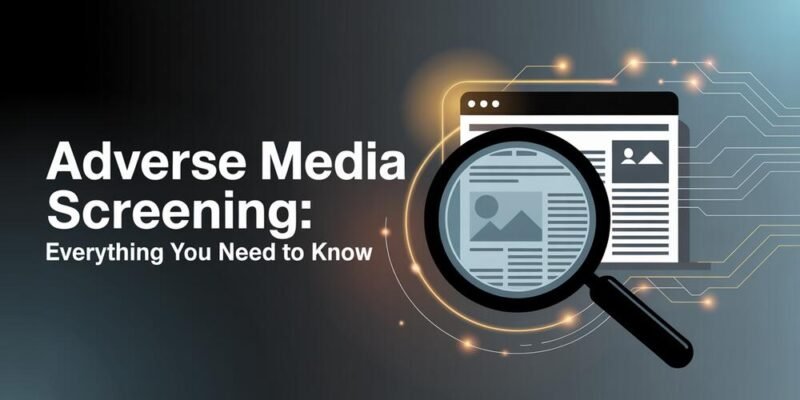In today’s rapidly evolving regulatory landscape, financial institutions, fintechs, and regulated businesses are under increasing pressure to comply with stringent anti-money laundering (AML) requirements. One crucial component of an effective AML program is adverse media screening. This practice helps organizations identify potential reputational and compliance risks before onboarding customers or continuing business relationships.
Below, we’ll explore adverse media screening, why it matters, and how adverse media screening services and software can streamline the process.
What Is Adverse Media Screening?
Adverse media screening—also known as negative news screening—identifies information from credible sources that links individuals or entities to illicit or high-risk activities. This includes involvement in money laundering, terrorist financing, fraud, corruption, organized crime, trafficking, and other illegal conduct.
Unlike traditional background checks, adverse media screening examines publicly available information—such as news articles, blogs, court records, and regulatory publications—to uncover potential risks that may not be present in conventional data sources. The aim is to create a more holistic risk profile of a person or business.
Why Adverse Media Screening Matters
Regulators across the globe, including the Financial Action Task Force (FATF) and national authorities, recommend or require adverse media checks as part of a risk-based approach to compliance. Failing to conduct proper screening can result in:
- Regulatory penalties
- Reputational damage
- Loss of customer trust
- Increased exposure to fraud or criminal activity
Adverse media screening protects businesses from financial crime and ensures they remain compliant with global and local AML regulations.
Adverse Media Screening Services
Many organizations turn to professional adverse media screening services to manage the complexity and volume of data involved in adverse media checks. These services help streamline compliance workflows by:
- Aggregating structured and unstructured data from millions of sources
- Delivering real-time alerts on emerging risks
- Providing risk categorization based on severity and relevance
- Integrating with customer onboarding and KYC systems
Top-tier service providers often incorporate machine learning and natural language processing (NLP) to ensure accuracy, reduce false positives, and identify meaningful patterns in large datasets. Whether you’re screening customers during onboarding or conducting periodic reviews, these services offer scalable and efficient solutions.
Benefits of Adverse Media Screening Software
The increasing demand for real-time and automated monitoring has given rise to sophisticated adverse media screening software. This technology-driven approach eliminates the manual burden of scanning thousands of articles and web pages.
Key benefits of adverse media screening software include:
- Automation: Reduces manual labor by automatically flagging high-risk profiles.
- Real-Time Alerts: Instantly notify compliance teams when new negative news emerges.
- Customizable Risk Parameters: Tailors the screening process to your industry, geography, or customer risk level.
- Integration Capabilities: Works seamlessly with KYC, CRM, and AML platforms.
- Audit Trails: Maintains records for regulatory audits and internal reviews.
Advanced software platforms offer multilingual support and deduplication features to enhance data quality and reduce operational fatigue.
Understanding the Adverse Media Database
A comprehensive adverse media database is at the heart of any effective screening system. This is a curated collection of structured and unstructured data points related to criminal activities, sanctions, regulatory actions, and negative news coverage.
A robust adverse media database typically includes:
- Global and local news outlets
- Sanctions lists and watchlists
- Government publications
- Court and legal records
- Blogs, forums, and social media (in some cases)
The quality and depth of the database directly impact the accuracy of risk assessments. As such, organizations should prioritize solutions that offer broad coverage and continuous updates.
The Role of Negative News Screening
While initial screenings are essential, Negative News Screening ensures ongoing due diligence throughout the customer lifecycle. This continuous surveillance identifies new risk factors that may arise after a customer has been onboarded.
Adverse media monitoring is especially critical in sectors like banking, cryptocurrency, insurance, and real estate, where long-term client relationships can carry hidden risks. With real-time monitoring tools, compliance teams can proactively:
- Detect emerging threats
- Investigate suspicious activity
- Escalate cases for enhanced due diligence.
- Update customer risk profiles.
This ongoing approach supports a proactive compliance strategy and ensures businesses stay ahead of potential threats.
Conclusion
Adverse media screening is a non-negotiable component of any modern AML and compliance program. By leveraging adverse media screening services, deploying robust screening software, utilizing an expansive adverse media database, and conducting ongoing monitoring, organizations can more effectively mitigate reputational and regulatory risks.
With financial crimes becoming more sophisticated, staying vigilant is no longer optional. A substantial adverse media screening framework empowers businesses to operate confidently, maintain regulatory compliance, and protect their reputations in a competitive and highly regulated world.
Do Read: Email Signature Software: Enhancing Branding, Communication, and Compliance













